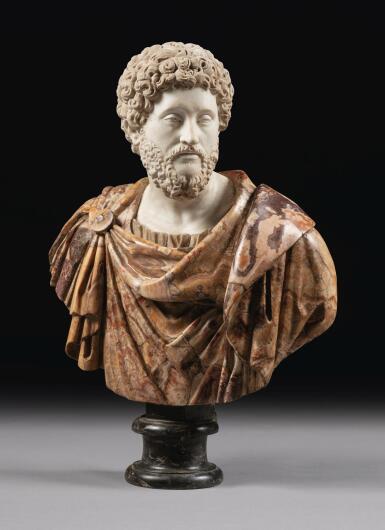Old Master Sculpture & Works of Art
Old Master Sculpture & Works of Art

ITALIAN, 17TH CENTURY, AFTER THE ANTIQUE | BUST OF EMPEROR COMMODUS (161-192 C.E.)
Auction Closed
December 3, 02:41 PM GMT
Estimate
50,000 - 70,000 GBP
Lot Details
Description
ITALIAN, 17TH CENTURY
AFTER THE ANTIQUE
BUST OF EMPEROR COMMODUS (161-192 C.E.)
white marble and Alabastro fiorito, on a nero portoro marble socle
bust: 74cm., 29⅛ in.
socle: 16cm., 6¼ in.
This powerful bust of the Emperor Commodus is broadly inspired by ancient portraits of the ruler of which an example is the bust in the Sala dei Busti of the Musei Vaticani, Rome (inv. no. 706). The present portrait shows Commodus dressed in the guise of a military general, wearing a tunic, a cuirass and a paludamentum, all in luxuriant Alabastro fiorito. Compare particularly with the portrait bust of Commodus at Houghton Hall, which was originally in the Albani collection before being acquired by Robert Walpole (note the positioning of the incised irises). The present bust differs, however, from ancient examples in that the head is turned to the sinister rather than the dexter. More pertinently, it diverges in the more stylised treatment of the hair, with broader curls created with a claw chisel, which specifically recalls Roman baroque sculpture. Analogous Emperor busts with sumptuous coloured marble torsi were created by members of the Della Porta family in the second half of the 16th century. Compare particularly with the work of Giovanni Battista Della Porta (1542-1597) who was active in Rome and was responsible for the series of Emperor busts in the salone d'ingresso of the Villa Borghese (Ioele, op. cit., figs. 66-77). The present bust is more Baroque in style however, with more prominently delineated hair with curls terminating in drilled holes, which would indicate a 17th century dating.
RELATED LITERATURE
G. Ieole, Prima di Bernini: Giovanni Battista Della Porta Scultore (1542-1597), Rome, 2016; G. Extermann and A. V. Braga, Splendor marmoris: I colori del marmo, tra roma e l'Europa da Paolo III a Napoleone III, Rome, 2016
